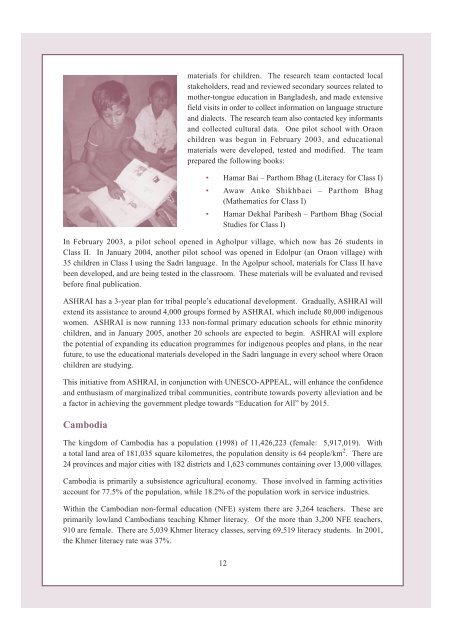Part I.pdf - MTB-MLE Network
Part I.pdf - MTB-MLE Network
Part I.pdf - MTB-MLE Network
Create successful ePaper yourself
Turn your PDF publications into a flip-book with our unique Google optimized e-Paper software.
materials for children. The research team contacted localstakeholders, read and reviewed secondary sources related tomother-tongue education in Bangladesh, and made extensivefield visits in order to collect information on language structureand dialects. The research team also contacted key informantsand collected cultural data. One pilot school with Oraonchildren was begun in February 2003, and educationalmaterials were developed, tested and modified. The teamprepared the following books:• Hamar Bai – <strong>Part</strong>hom Bhag (Literacy for Class I)• Awaw Anko Shikhbaei – <strong>Part</strong>hom Bhag(Mathematics for Class I)• Hamar Dekhal Paribesh – <strong>Part</strong>hom Bhag (SocialStudies for Class I)In February 2003, a pilot school opened in Agholpur village, which now has 26 students inClass II. In January 2004, another pilot school was opened in Edolpur (an Oraon village) with35 children in Class I using the Sadri language. In the Agolpur school, materials for Class II havebeen developed, and are being tested in the classroom. These materials will be evaluated and revisedbefore final publication.ASHRAI has a 3-year plan for tribal people’s educational development. Gradually, ASHRAI willextend its assistance to around 4,000 groups formed by ASHRAI, which include 80,000 indigenouswomen. ASHRAI is now running 133 non-formal primary education schools for ethnic minoritychildren, and in January 2005, another 20 schools are expected to begin. ASHRAI will explorethe potential of expanding its education programmes for indigenous peoples and plans, in the nearfuture, to use the educational materials developed in the Sadri language in every school where Oraonchildren are studying.This initiative from ASHRAI, in conjunction with UNESCO-APPEAL, will enhance the confidenceand enthusiasm of marginalized tribal communities, contribute towards poverty alleviation and bea factor in achieving the government pledge towards “Education for All” by 2015.CambodiaThe kingdom of Cambodia has a population (1998) of 11,426,223 (female: 5,917,019). Witha total land area of 181,035 square kilometres, the population density is 64 people/km 2 . There are24 provinces and major cities with 182 districts and 1,623 communes containing over 13,000 villages.Cambodia is primarily a subsistence agricultural economy. Those involved in farming activitiesaccount for 77.5% of the population, while 18.2% of the population work in service industries.Within the Cambodian non-formal education (NFE) system there are 3,264 teachers. These areprimarily lowland Cambodians teaching Khmer literacy. Of the more than 3,200 NFE teachers,910 are female. There are 5,039 Khmer literacy classes, serving 69,519 literacy students. In 2001,the Khmer literacy rate was 37%.12
















